About the same time that I started this blog in 2007, I read an autobiography of one of the Australian Officers held prisoner in Burma in the second world war. One of the morale raising exercises they did in camp was to have story telling sessions, the author was surprised at just how interested everyone was in each others stories. As the English boys who lived in villages were fascinated by the stories told by the Australian boys from country Queensland and vise versa. Those stories did raise morale, as it kept them connected as well as reinforcing their essential sameness, their shared humanity.
I often held onto that tidbit I gleaned from a story, as it helped me to think that I really wasn’t all that odd by sharing my own stories here.
Because, Oh Boy, once you start writing and sharing your own stories ON THE INTERNET, some people get really cranky with you. Luckily a lot more of you encourage me by saying nice things, so here I am again, this time my story is for my daughter’s friend Becky, who is by proxy my friend as well.
I shared a local news item on my facebook page about the serious lack of rain here in the midlands of Tasmania
I added my own lead in text to the article saying,
It is very dry here. The dams are empty. My topsoil is blowing away. The vegie garden is fallow as we simply do not have the water. My yard wallabies have been reduced to eating the sags (zero nutrition) as the scarab beetles decimated the silver wattles which are their go to drought food. It is hard country up here in the midlands and if it doesn’t rain soon we will be in big trouble.
Becky commented later that evening with,
“This is off topic, and for that I apologize, but I read this status out loud to my husband because it was just the…. the most Australiany status I’ve ever seen in my newsfeed
(drough notwithstanding).
Do you really have yard wallabies?”
I was going to reply to Becky on facebook with a photo of my ‘yard’ so that she could see where I lived and why the wallabies were in my backyard. As my backyard is not like Becky’s backyard at all. It is probably not a lot like your backyard either Internet, so after the longest introduction in the history of long bloggy introductions, I shall begin.
This is my backyard, I have deliberately left the balcony rail in the image for context, I am standing three quarters of the way along the back balcony and I am looking southwest. Monty is lurking just on the edge of the bracken.
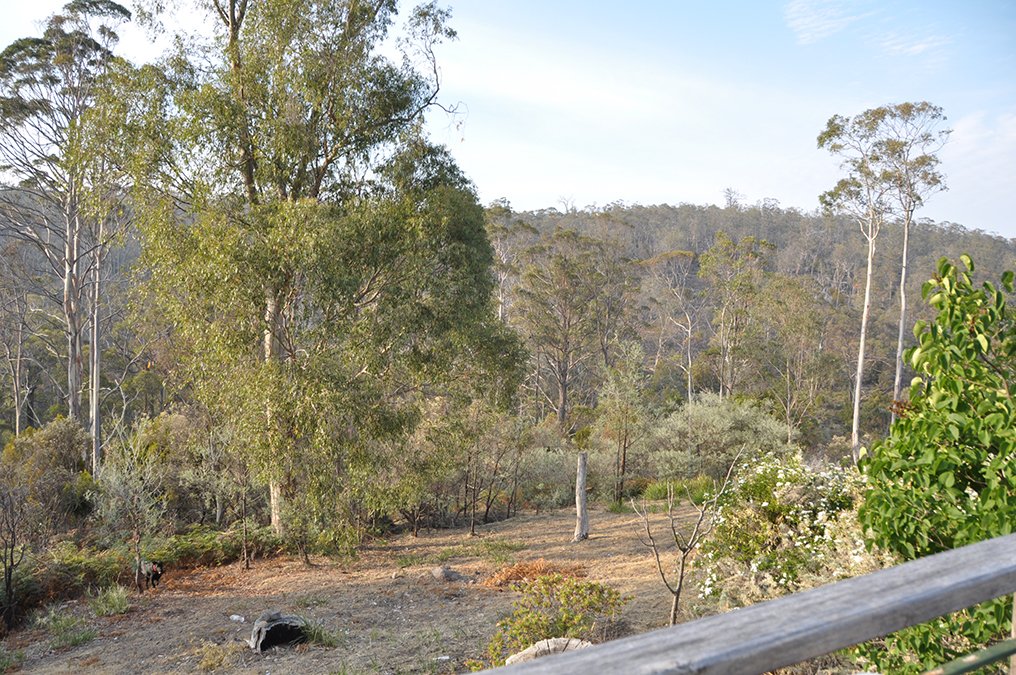
By the magic of the internet and the power of cameras, I am now looking up towards the back of my house, you can see how crunchy the grass is.
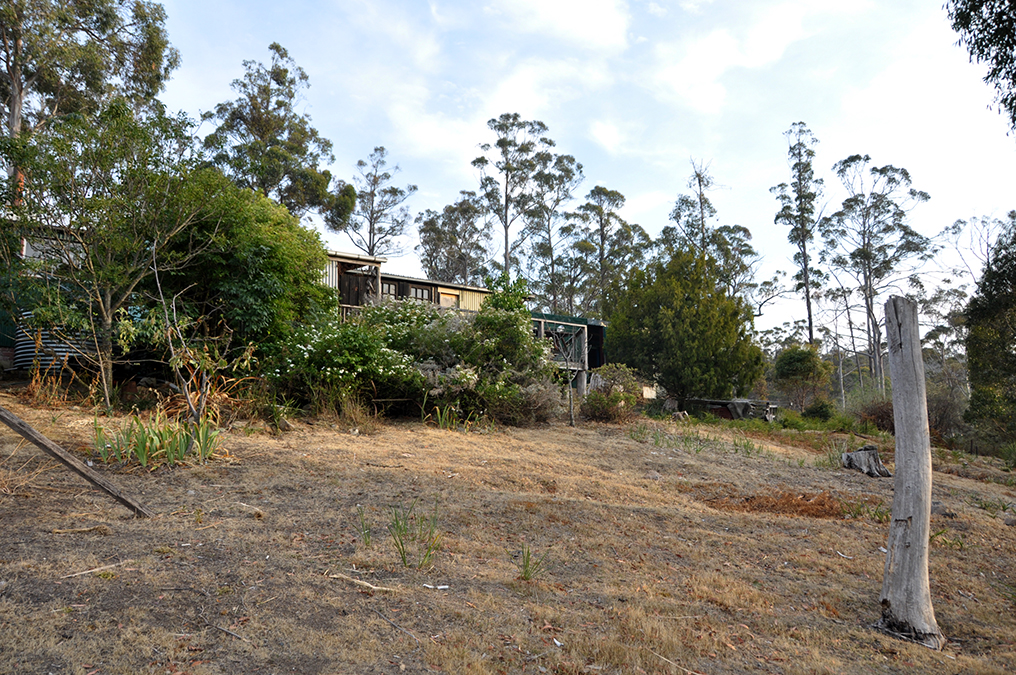
Here is an image showing the dead and dying grasses. Mixed in here with the dead grass, the yellow patches are alpine cushion plants that are not dead yet, but they are close. Normally we have a good mix of native grasses, which are super tough, some native plants that look similar to a spagnum moss but isn’t a moss and native wildflowers. As you can see there is no feed left here at all.
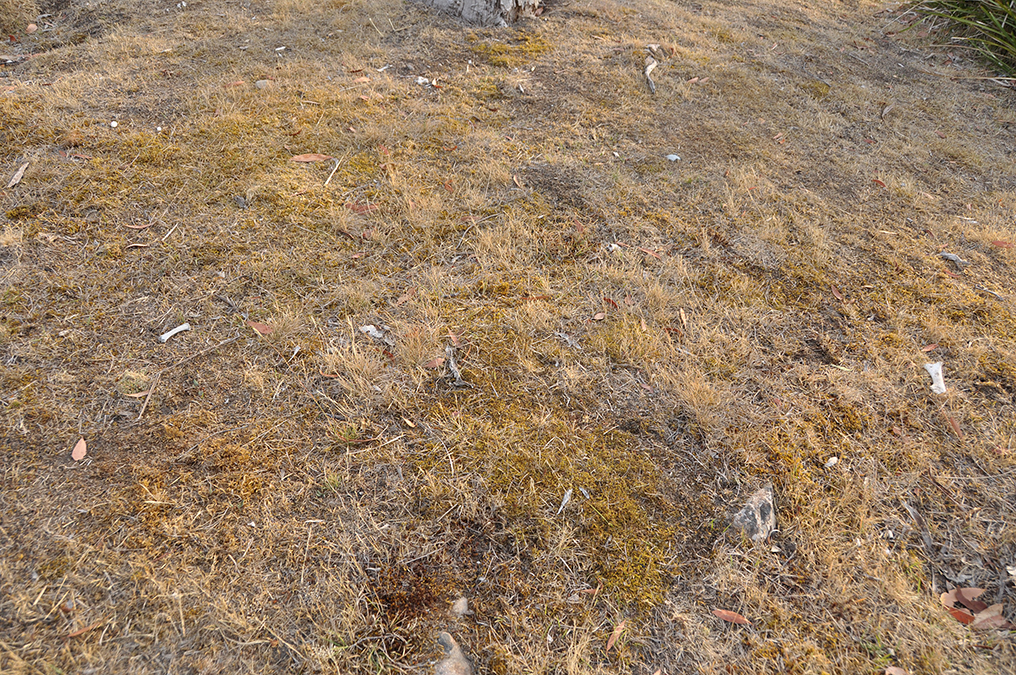
This is my front yard, looking north up to my studio, in this image you can sort of see the remnants of the new orchard, four plums and a cherry tree, behind the upside down bath. The green scarab beetles did a number on these trees and they are really struggling. I am keeping them going with the waste water from my studio and washing machine as I have about twenty plums on four trees, that I would really like to harvest but I reckon the currawongs will beat me to them.
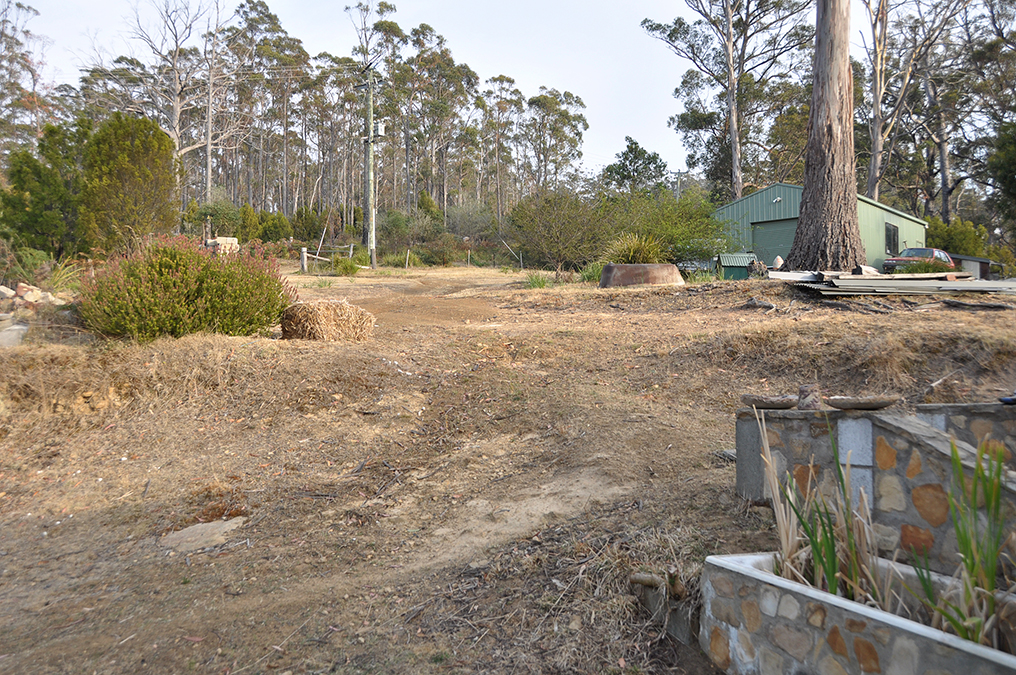
Here is a photo of the sags up by the front gate, Sag is one of the common names for a native tussock grass, the other is saw grass, it’s proper name is Lomandra longifolia. When I saw my resident Rufous Wallabies (Pademelons for the pedants) eating the saw grass, I knew they were in a bit of trouble, as there is very little calorific value in the grass. As an aside, you can eat the roots, they are a long white starchy tuber but they take a bit of digging to get at and are not worth the effort unless you are hungry and out of potatoes.

I do not make any decisions lightly, I gave my decision to feed the wallabies a lot of thought before I committed to it. I weighed the pros and cons, talked about it with The Spouse, who had already been throwing his vegie peelings off the balcony rather than putting them into the compost. I angsted at Veronica and I also rang a local wildlife conservationist to get confirmation of what I already knew. I have been actively involved with this bit of land for over 25 years now and I know it and its residents well.
I really am in a catch 22 situation here as it is drought that controls the wallaby population, the females will not breed when food is scarce. There is also a risk that I will be encouraging half the wallabies on the mountain to come into the yard. But the simple fact is internet, I can not just sit back and do nothing and let them die.
Another major factor in my decision to feed the wallabies, was the decimation of the silver wattles. The green Scarab beetles came in and just stripped the trees bare, wallabies will eat the wattles when they are hungry enough, as wattle isn’t their preferred food but the trees have been stripped back by the beetles.
These are the wattles on the edge of the bush at the bottom of my back yard, normally you can not see through them. The wallabies sit on the other side of the ditch, watching to see if it is safe to hop out into the open. When a goofy black Labrador doesn’t appear out of nowhere to chase them away, they tentatively come out of the bush.

I have a couple of resident females, with Joeys who are often out in the daylight, hovering on the edges of the scrub and it is this family that I wanted to feed. On advice from Bonorong, I am feeding them Wallaby pellets each night, not enough to make them fat, lazy and dependent, just enough to keep them alive.
The Pellets need to be 18% protein and if you can’t get wallaby pellets (Roberts at Bridgewater has them, as does one of the animal feed places) Guinea pig pellets are the next best thing. The pellets are soft enough to not damage their jaws and at 18% protein, there are enough goodies in there for the Joey’s continued development. As all the dams are drying up, I have put out extra water. Normally wallabies get their water from the food they eat but as the moisture content of the vegetation lessens, the wallabies need to drink more than usual. This is why I am now seeing roadkill on the side of the road in the suburbs, as they are on the move, looking for food and water. As an aside, the snakes are also on the move, as I have seen more snakes here in the past month than I have seen in the past 25 years.
This is not one of my snakes, I took this photo with my phone last year at a reptile display, though I am feeling the urge to go camera hunting some snakes.

Back to the Wallabies, here you go Becky, finally, here is a wallaby. These little brown wallabies are known locally as Rufous wallabies but they are actually a Pademelon, (Thylogale billardierii) We have two types of wallabies here at my home. The other species of wallaby that are found here is a Bennetts Wallaby they are larger grey wallabies, that are super spooky and impossible to photograph with the point and shoot. The Bennett’s also come in for the water but they tend to stick to the front of my property around the studio and as they do not stay for long or come down to the back yard, I am not currently feeding them. Or at least I do not “think” I am.
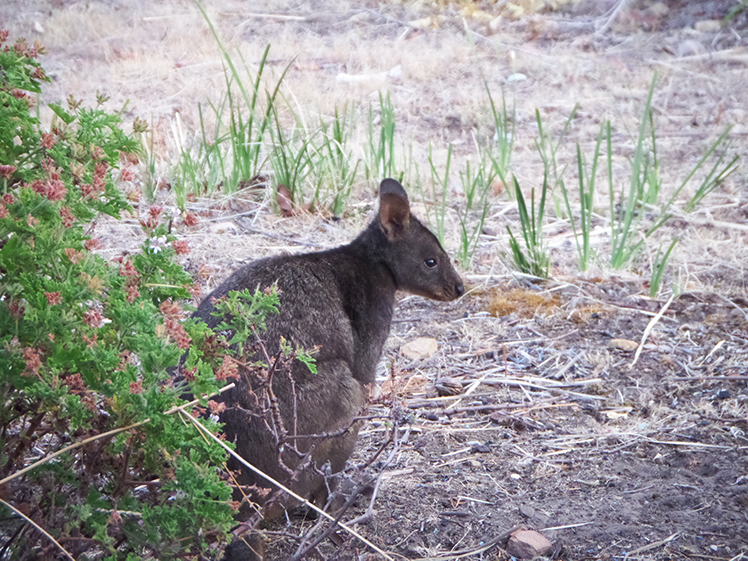
Here is a male wallaby, you can see his malesness on display resting on the ground by his foot, he has a huge set of knackers and spends all his time chasing the girls making a tchhk tchhk tchhk sound. The girls just roll their wallaby eyes at him and hop away.
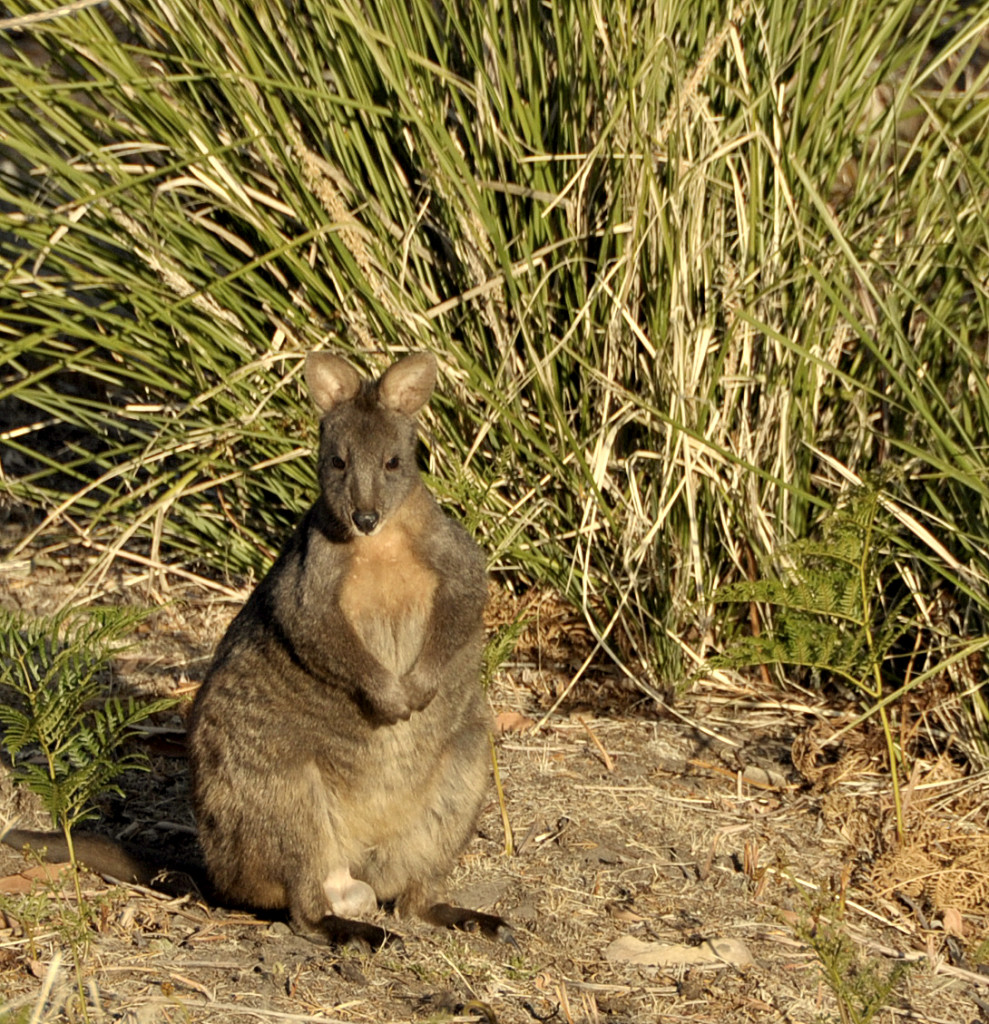
There is a youngster living under the jasmine here. I think its mother was run over as it hung about in the open for a few days looking a bit lost. All I could do at the time to help it, was lock the gates so the dogs didn’t go down the back and hope it managed to survive. Which, surprisingly it has managed to do, but it is super skittish as it hasn’t learned the trick of squatting and pretending to be invisible. As soon as it sees me it gives a loud warning thump and vanishes back under the jasmine, which in turn makes all the other wallabies hop away in collective fright.
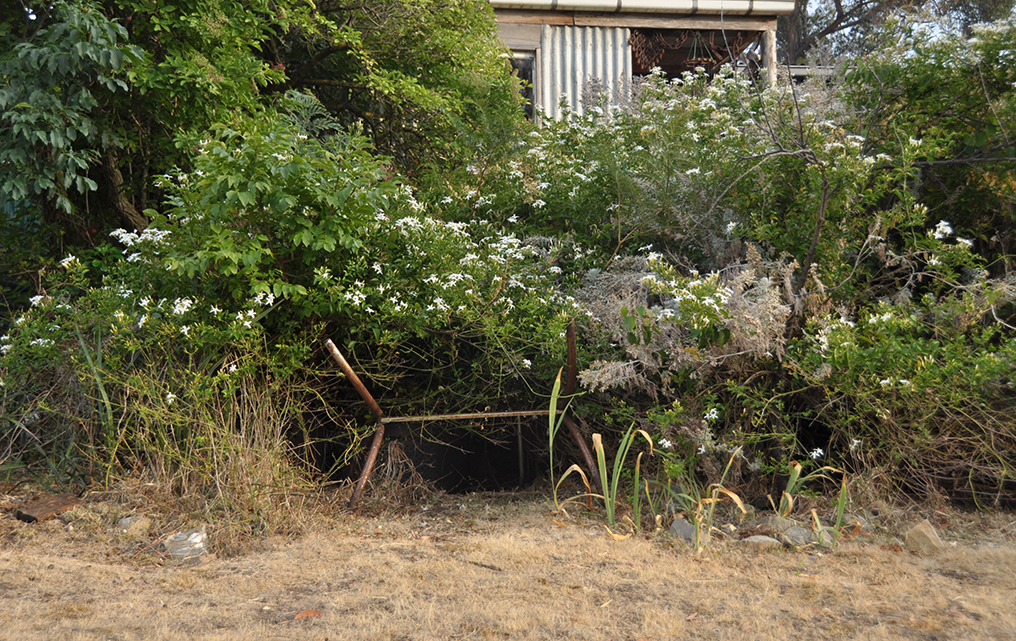
As I was wandering around the edge of my yard taking photos for this story, I noticed that the Kangaroo Apple had been well nibbled. This plant is a drop in, it was delivered to me by a bird about ten or fifteen years ago and is not a native to this area. It grows into large bush and the fruit are edible bush tucker when they turn orange, the birds also like them. The Kangaroo Apple lives on for a few years, then it dies and another one will pop up somewhere else. BUT it doesn’t seem to do any harm and so I leave it be.
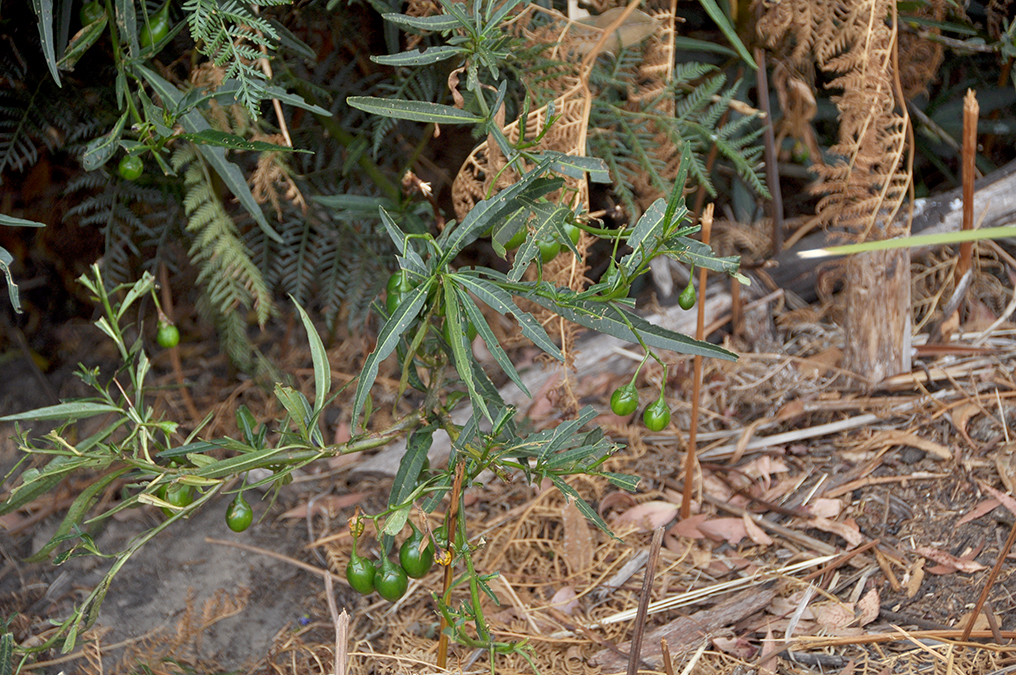
Trying to photograph the wallabies as they hop out just before dusk for a feed is really tricky. These are wild animals that will scatter and run at the first unusual sound. I can’t use the Nikon as the sound of the shutter spooks them. Luckily my little point and shoot is silent and takes a decent enough photo.
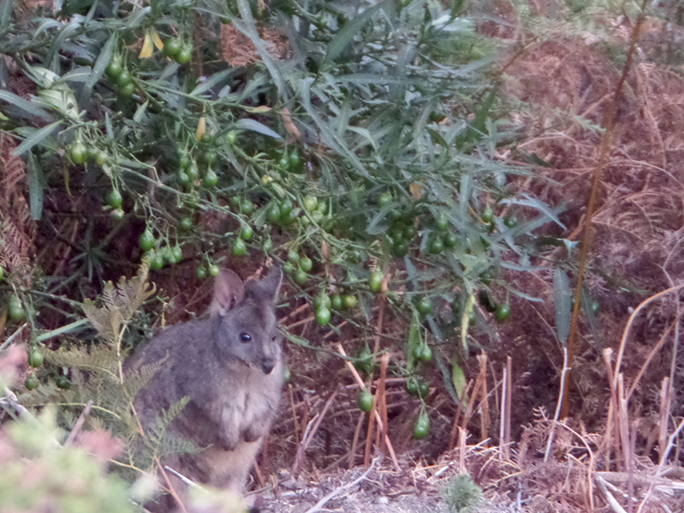
This girl has a Joey in her pouch, I was absolutely nailed by the mosquitoes taking this photo as I had to sit really quietly without moving for ages. I was interested to see that the joey was eating the pellets, whilst staying safely in the pouch.

The photos of the wallabies are the best ones I can get as I am not a very good Ninja. My nose starts to itch the minute I have to sit still and that itch spreads and I begin to fidget and brrrrrttttt just like a bag of marbles dropped onto concrete, the wallabies instantly scatter in all directions.
The Joey in the photo above is now out of the pouch and it is hilarious to watch it learning to master its hopping technique. The full grown wallabies jump along with a smooth economy, a nice measured jump, long and low. The joeys like to JUMP REALLY HIGH. Sproing sproing, bounce, bounce, YIPPEE. I am trying to film it for you but as the Mothers are the most cautious, they come out later than the others and so the light is very low by the time they venture up to the pellets. It is also peak mosquito time and my fidgeting makes for tricky filming. I will keep on trying though.
So there we go Becky, the very long answer to your question, is yes I really do have yard wallabies.

Comments on this entry are closed.
I just hope – the rains come soon, for you and your district
I hope also, that, you are not in any bushfire danger and that you stay safe and well.
I hope you get a chance for garden, fruit trees, and wallabies to flourish
Thank you for this story, I really liked your telling of it, plus the photos – which also tell your story
Blowing you, (in the form of blowing a dandelion concept) good hopes and wishes as you pass through your seasons xx
Really enjoyed this, I’m glad you are keeping them going. We saw so many wallabies as we were driving home late yesterday from Coles Bay, eating whatever was green along the Lake Leake road. The grass wasn’t greener on the other side of the road so hopefully they didn’t end up squished.
Interesting how everybody’s backyard is different. Thank you for sharing yours and posting the pictures that I enjoyed so much.
You are always so compassionate to everyone and everything! Such a loving heart. I had a happy ache looking up the hill at the studio, that last gift of your dear mother. You’re so very connected to this place, Kim. We moved about so much when I was little I wisht for something like that. 🙂